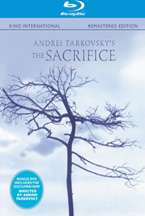
(Buy the 2-Disc Remastered Edition of The Sacrifice on DVD or Blu-ray.)
The Film
Completed in 1986, the year of his death from lung cancer, The Sacrifice is the final film by the Russian director Andrei Tarkovsky. The unfortunate (and controversial*) circumstances of Tarkovsky’s illness, which was reportedly discovered while the film was in production, when tied in with the specifics of the plot, has historically heightened the sense that this film was intended as a grand, final “statement” on cinema, on life, on war, on death and on the fundamental question of faith. But when held against Tarkovsky’s other works, particularly Nostalghia which proceeds it and with which it shares an ironic, sympathetic relationship, The Sacrifice stands primarily as an incredibly rich, complex addition to Tarkovsky’s cinematic legacy without the responsibility of carrying the maudlin baggage of his untimely death. Tarkovsky was always dealing with the fragile nature of human life and our connection to our own history; The Sacrifice lands squarely within the poetic realm of his deepest concerns.
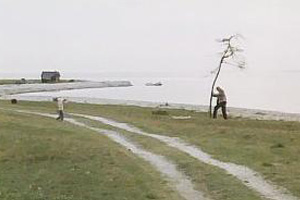 The film opens with Alexander (Erland Josephson, here in his second role for Tarkovsky) setting up an old tree beside the sea, talking to his son about the responsibility of caring for its growth. Alexander, an actor who has become a successful writer and academic, is spending his 50th birthday with his wife, son and friends at the family’s remote country home when, seemingly from nowhere, the sound of fighter jets scrambling overhead rattles the house and an announcement is made that global nuclear war is imminent. Confronted with annihilation by forces out of his control, Alexander makes a pact with God; if by his actions he may avert this global disaster, he will give up his family home and take a vow of silence—a profound sacrifice of everything that has defined his life. In order to put his promise into motion, Alexander visits the home of one of his part-time servants, a quiet, humble woman who is also a witch and, after making love with her, wakes on his couch to find that the world has either been saved or that he has simply dreamed of its possible nuclear end. Determined to keep his vow to God, Alexander remains home as his family and guests set out on a walk, and he proceeds to silently burn his house to the ground. In the film’s final shot, Alexander’s son is seen laying beneath the tree they planted together, innocence preserved with the hope for a new, brighter future a palpable presence on screen.
The film opens with Alexander (Erland Josephson, here in his second role for Tarkovsky) setting up an old tree beside the sea, talking to his son about the responsibility of caring for its growth. Alexander, an actor who has become a successful writer and academic, is spending his 50th birthday with his wife, son and friends at the family’s remote country home when, seemingly from nowhere, the sound of fighter jets scrambling overhead rattles the house and an announcement is made that global nuclear war is imminent. Confronted with annihilation by forces out of his control, Alexander makes a pact with God; if by his actions he may avert this global disaster, he will give up his family home and take a vow of silence—a profound sacrifice of everything that has defined his life. In order to put his promise into motion, Alexander visits the home of one of his part-time servants, a quiet, humble woman who is also a witch and, after making love with her, wakes on his couch to find that the world has either been saved or that he has simply dreamed of its possible nuclear end. Determined to keep his vow to God, Alexander remains home as his family and guests set out on a walk, and he proceeds to silently burn his house to the ground. In the film’s final shot, Alexander’s son is seen laying beneath the tree they planted together, innocence preserved with the hope for a new, brighter future a palpable presence on screen.
Of course, The Sacrifice is so much more than a plot summary could allow; girding the film is a philosophical debate about the nature of time (represented here by Nietzsche’s philosophy of Eternal Return** pitted against the nostalgia for the trappings and comforts of memory symbolized by Alexander’s home and his sacrifice of it) as well as a formal rhyming subtext with Leonardo da Vinci’s painting The Adoration Of The Magi, which provides a religious counterpoint to Alexander’s own gift/sacrifice.
And on and on; as it should be with all great works of art, Tarkovsky’s work is an open door to an almost infinite set of interpretations. The Sacrifice is a complex, mature work of a master filmmaker, perhaps not the most accessible entry point for those looking to discover Tarkovsky (I suggest taking the films in chronological order of their creation), but an essential work by a true poet of the cinema whose films will endure forever.
Blu-ray Presentation
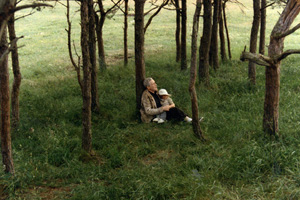 The Sacrifice is presented here in Blu-ray format by Kino International, who have re-mastered and restored the film with great skill. I was able to compare the original DVD transfer (on an up-converting DVD player) against the Blu-ray (seen on a 1080i consumer Blu-ray player in my case) and without question, Kino has done an excellent job in providing a sharp, clear image that retains much of the “filmic” warmth of a celluloid print. Of course this film, shot by Sven Nykvist, made in Sweden and starring Erland Josephson, is perhaps the most “Bergman-esque” of Tarkovsky’s works, with sepia toned interiors, blacks and browns blending together in very low light, dimly lit faces in tight close-up, etc.; this is a nightmare for a video transfer, and the original DVD of the film showed the challenges of capturing the depth of these images.
The Sacrifice is presented here in Blu-ray format by Kino International, who have re-mastered and restored the film with great skill. I was able to compare the original DVD transfer (on an up-converting DVD player) against the Blu-ray (seen on a 1080i consumer Blu-ray player in my case) and without question, Kino has done an excellent job in providing a sharp, clear image that retains much of the “filmic” warmth of a celluloid print. Of course this film, shot by Sven Nykvist, made in Sweden and starring Erland Josephson, is perhaps the most “Bergman-esque” of Tarkovsky’s works, with sepia toned interiors, blacks and browns blending together in very low light, dimly lit faces in tight close-up, etc.; this is a nightmare for a video transfer, and the original DVD of the film showed the challenges of capturing the depth of these images.
Kino’s Blu-Ray transfer does a very good job in maintaining the film’s palette, but does suffer in some moments from a few compression artifacts, most notable in the movement of faces in tight close-up (note the texture of the skin and the blending of color from the light’s focal point on the actor’s faces in close-up as it fades into the darkness that surrounds the face) as well as in the beige and white interior walls during a few of the quicker pans, zooms and jump cuts, particularly as night settles on Alexander’s house. Still, there are some stunning moments of clarity, especially in the dark bed of the witch (the crisp corner of the bed sheet hangs delicately in the warm light) and in the exteriors of the film’s opening and finale, all of which contribute to the overall contrast in the lighting scheme of the film. Daylight and darkness are primary agents in this film, and Nykvist’s lighting here is incredible in and of itself, so it is nice to see these images generally presented with such clarity and richness.
The film is presented in its original 1.66:1 aspect ratio with a 2.0 mono audio track that is very clean and precise. Of course, as with any Tarkovsky film, dubbing, foley and ADR abound and the limited range of audio in his films provides a tight focus on select audio elements; this is not THX or Dolby stuff, but instead a spare, clean soundtrack that is used to place emphasis where it is required, without distraction. That said, if you doubt the power of a good old-fashioned mono track to surprise you, just wait for the moment in the film when the fighter jets scramble over Alexander’s house; the dishes in my cupboards were rattling in sympathy with those in the film.
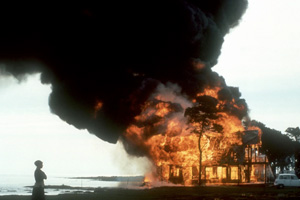 As with the original DVD version of this film, the Blu-ray is packaged with one of the great “bonus features” of all time, Directed By Andrei Tarkovsky, a documentary feature that shows Tarkovsky at work on The Sacrifice, punctuated by readings from his masterwork on filmmaking, Sculpting In Time (in my opinion, the best book ever written about the art of film). This film, here again on a standard definition DVD (and not noticeably different from the version that appeared as part of the original standard def Sacrifice DVD), is almost as essential as the feature it supports and remains a vital document of the artist’s process and philosophy. Be sure to catch Chapters 10 and 11 of this disc, entitled Take One and Take Two, which are among the most moving, heartbreaking sequences about the process of making a movie you’ll ever see.
As with the original DVD version of this film, the Blu-ray is packaged with one of the great “bonus features” of all time, Directed By Andrei Tarkovsky, a documentary feature that shows Tarkovsky at work on The Sacrifice, punctuated by readings from his masterwork on filmmaking, Sculpting In Time (in my opinion, the best book ever written about the art of film). This film, here again on a standard definition DVD (and not noticeably different from the version that appeared as part of the original standard def Sacrifice DVD), is almost as essential as the feature it supports and remains a vital document of the artist’s process and philosophy. Be sure to catch Chapters 10 and 11 of this disc, entitled Take One and Take Two, which are among the most moving, heartbreaking sequences about the process of making a movie you’ll ever see.
If you are a fan of Tarkovsky’s work, the Kino International Blu-Ray edition should provide a tremendous incentive to re-visit The Sacrifice in its finest home video presentation to date. If you’re new to the director, you can do no wrong here. For me, a must have.
— Tom Hall
* Theories abound that Tarkovsky, his wife Larisa Tarkovskaya and the actor Anatoli Solonitsyn where exposed to a toxic chemical while making the film Stalker, which might explain how all three of them died from the same form of lung cancer. there are other, more troubling theories as well, but I’ll leave you to Google to uncover them.
** A quick summary that will deeply understate the complexity and richness of Nietzsche’s idea of Eternal Return: Time is a single, linear road heading before us (the future) and behind us (the past). In every moment we live, time stretches out before us, an eternity in both directions. Because time is infinite in each direction, all possible lives have existed before and will exist again. As such, life itself is an eternal process of returning to the same moment on the same road, over and over and over again, each moment played out in the same way by the same actors, over and over again, forever. In The Sacrifice, Tarkovsky has presented a truly enormous, definitive moment (the onset of nuclear war) to set the dramatic stakes for Alexander’s own confrontation with time and his decision to reject (or to sacrifice as it were) his nostalgic view of life in favor of a silent embrace of Eternal Return. To showcase his rejection of the need to cling to nostalgia, Alexander burns down his house, immolating all of the memories and personal history it contains.
This is a particularly potent metaphor for a film, which according to Tarkovsky, is itself time preserved as a multi-dimensional sculpture, each moment captured by the lens is played out over and over again by the same players in the same sequence as viewed by the viewer in his or her own moment in time. In a startling coincidence, this point was made even more clear during the production of the film itself; during the first take of Alexander burning down the house, Sven Nyquist’s camera jammed and no editable footage of the event was captured. The house burned anyway. Tarkovsky’s crew had to re-build the house from scratch and a few days later, the director returned to burn it down again. This time, the footage was captured and represents the penultimate sequence in the film.








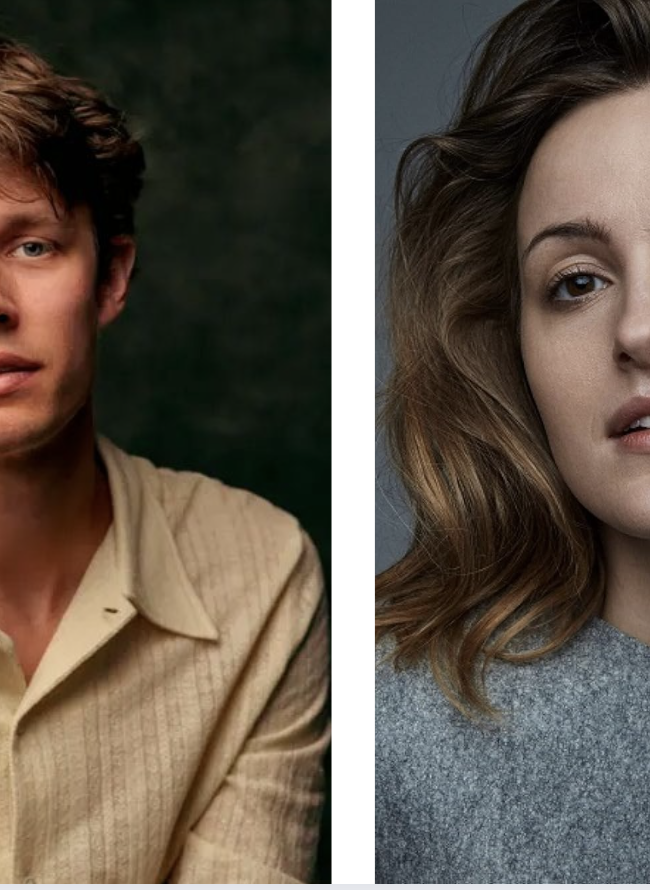
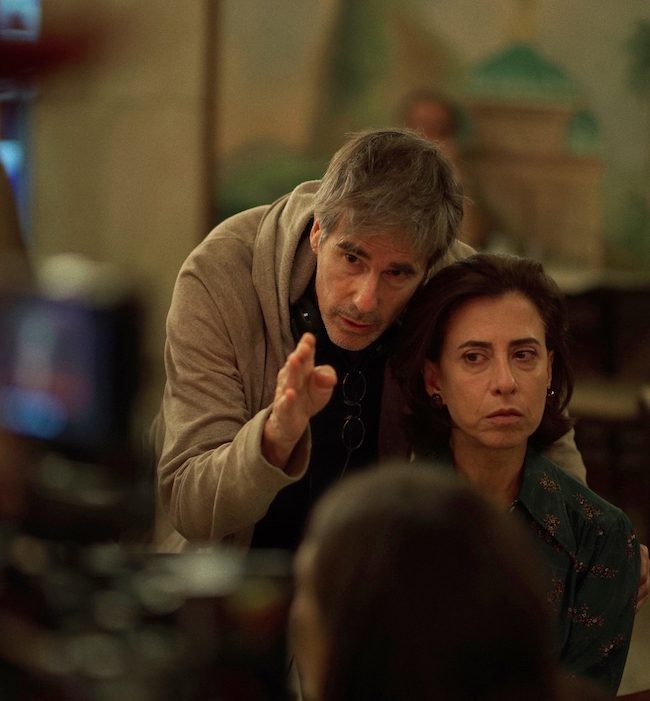


Pingback: HOME VIDEO PICKS – Hammer to Nail
James McNally
The Sacrifice was probably the first “art film” I ever saw, and if I remember correctly, it was in 1987 or 1988, just after my own mother’s early death from lung cancer. Although I didn’t quite understand everything that was going on, I sure as hell felt it. The threat of nuclear annihilation hung over my own adolescence and early adulthood, and to see a Russian (a RUSSIAN!) director expressing it as well may have done more to mature my own view of the Cold War than anything on the news. As well, knowing that this was his final film saddened me, even as I was just discovering him. I felt the same way upon discovering Kieslowski a few years later.
Unfortunately, I haven’t revisited the film in more than 20 years, so I’m eager to get my hands on this blu-ray. Your review has only sharpened my eagerness. Thanks!
Jan
Just a quick comment: it’s important to realise this film should NOT be treated as a “testament”. Tarkovsky didn’t find out about his illness until after the completion of the shooting (let alone completion of the screenplay). Everyone connected with the production (e.g. Layla Alexander-Garrett in her book “Andrei Tarkovsky: the Collector of Dreams”) is adamant about this point. The director was already engaged to shoot “Hoffmanniana” next.
Articles on ADR
Anyone who has been through the court systems can tell you that it is an expensive process. It is generally less expensive than a formal litigation process.
Going through the court system can cause some people severe stress. In a dispute resolution environment, the parties are treated in a far more relaxed manner. It is thought that when one discusses in a relaxed manner, there is clarity of thought and the process can move along quickly and efficiently.
All matters between the parties are kept in strict confidence.